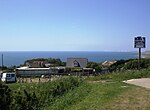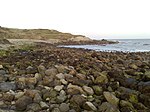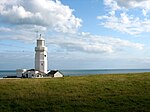St Catherine's Oratory
Buildings and structures on the Isle of WightEnglish Heritage sites in the Isle of WightGrade II listed buildings on the Isle of WightGrade II listed lighthousesLighthouses completed in 1328 ... and 4 more
Lighthouses in EnglandTourist attractions on the Isle of WightTowers completed in the 14th centuryUse British English from June 2015

St. Catherine's Oratory is a medieval lighthouse on St. Catherine's Down, above the southern coast of the Isle of Wight. It was built by Lord of Chale Walter de Godeton (sometimes spelled "Goditon") as an act of penance for plundering wine from the wreck of St. Marie of Bayonne in Chale Bay on 20 April 1313. The tower is known locally as the "Pepperpot" because of its likeness to a pepper shaker.
Excerpt from the Wikipedia article St Catherine's Oratory (License: CC BY-SA 3.0, Authors, Images).St Catherine's Oratory
Blackgang Road,
Geographical coordinates (GPS) Address External links Nearby Places Show on map
Geographical coordinates (GPS)
| Latitude | Longitude |
|---|---|
| N 50.593167 ° | E -1.303889 ° |
Address
St Catherine's Oratory (The Pepperpot)
Blackgang Road
PO38 2JB
England, United Kingdom
Open on Google Maps









